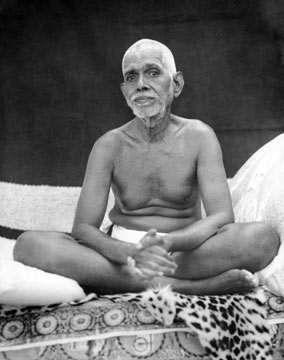|

|
Ramana Maharshi Self Inquiry Meditation Instructions
Question : How should a beginner start this practice?
Ramana Maharshi: The mind will subside only by means of the enquiry
`Who am I?' The thought 'Who am I?', destroying all other thoughts, will
itself finally be destroyed like the stick used for stirring the funeral
pyre. If other thoughts rise one should, without attempting to complete
them, enquire `To whom did they rise?' What does it matter however many
thoughts rise?
At the very moment that each thought rises, if one vigilantly enquires
`To whom did this rise?', it will be known `To me'. If one then enquires
`Who am I?', the mind will turn back to its source [the Self] and the
thought which had risen will also subside. By repeatedly practising
thus, the power of the mind to abide in its source increases.
Although tendencies towards sense-objects [vishaya
vasanas], which have been recurring down the ages, rise in countless
numbers like the waves of the ocean, they will all perish as meditation
on one's nature becomes more and more intense. Without giving room even
to the doubting thought, `Is it possible to destroy all these tendencies
[vasanas] and to remain as Self alone?', one should persistently cling
fast to self-attention.
As long as there are tendencies towards sense-objects in the mind, the
enquiry `Who am I ?' is necessary. As and when thoughts rise, one should
annihilate all of them through enquiry then and there in their very
place of origin. Not attending to what-is-other [anya] is non-attachment
[vairagya] or desirelessness [nirasa]. Not leaving Self is knowledge [jnana].
In truth, these two [desirelessness and knowledge] are one and the same.
Just as a pearl-diver, tying a stone to his waist, dives into the sea
and takes the pearl lying at the bottom, so everyone, diving deep within
himself with non-attachment, can attain the pearl of Self. If one
resorts uninterruptedly to remembrance of one's real nature [swarupasmarana]
until one attains Self, that alone will be sufficient.
Enquiring `Who am I that is in bondage?' and knowing one's real nature [swarupa]
alone is liberation. Always keeping the mind fixed in Self alone is
called 'self-enquiry', whereas meditation [dhyana] is thinking oneself
to be the absolute [Brahman], which is existence-consciousness-bliss
[sat-chit-ananda]. Source: from David Godman Excellent Book "Be As You
are"
Related Ramana Maharshi Articles:
Who am I Technique is direct but
Difficult
Ramana Maharshi on Meditation and
Investigation
Why is self-enquiry more direct than other
methods
Is soham (the affirmation `I am he') same as `Who am I
Ramana Maharshi - Only the quest `Who am
I?' is necessary
To enquire `Who am I ?' really means
finding source of `I'-thought
Ramana Mahashi on Turiya and Samadhi
Ramana Maharshi Free PDF
Books Download
Ribhu Gita chapter
26 and 40 verses of Reality
Bhagwan Ramana Maharshi Teachings Blog (opens in a new window)
^Top
Back to Ramana Maharshi Meditations |
|
